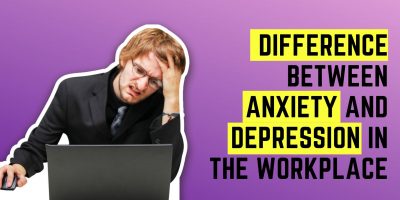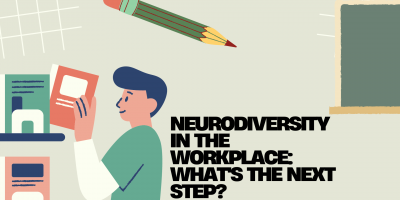
Difference between Anxiety and Depression in the Workplace
Dive into the distinctions between anxiety and depression, their impact on the workplace, and how employers can recognize and address them.


Founder of Inclusif

Founder & Owner of Mental Wealth at Work

Chief Medical Officer at Aaptiv

Co-owner and Content Manager at Damien McEvoy Plumbing

Managing Director of H-Training
Anxiety and depression as serious mental health conditions can significantly impact an individual’s ability to function at work.
Many frequently mistake them for one another, primarily because they share symptoms and causes.
However, despite the overlap, there is a difference between anxiety and depression.
This article will dive into the distinctions between both conditions and review what causes them. Additionally, it will discuss their impact on the workplace and how employers can recognize and address them.
Anxiety is an emotional reaction that causes fear, worry, or uneasiness in response to actual or perceived danger.
Feeling anxious can sometimes be good since it is the body’s natural reaction to threats. However, if the feeling becomes persistent or excessive, it can have debilitating effects.
In the workplace, anxiety manifests with frustration, tiredness, or irrational worry. “When an individual is experiencing anxiety in the workforce, they often have high expectations of themselves and others, showing frustration for not achieving these goals fast enough.
They show restlessness and may find it difficult to remain seated. They often fidget with their hands or feet or squirm in their seat. These individuals also have difficulty enjoying leisure activities quietly.”, as Dr. Martin Raffaele from Inclusif explains.
Depression, on the other hand, is a mood disorder characterized by persistent sadness, hopelessness, and worthlessness.
It is more than just feeling “sad” or “blue.”
It affects how one thinks, feels, and behaves daily and can significantly interfere with relationships, work, and other activities.
Employees suffering from depression “often find it difficult to maintain their energy on performing a task. They often lose objects, such as their phone or documentation.
They show a poor sense of timing and inconsistency in their actions. Their inability to follow instructions to complete a set task or duty is not due to oppositional behavior or failure to understand the instructions. They appear to have reduced energy levels.”, elaborates Dr. Martin Raffaele.
It is essential to note that some individuals may experience depression and anxiety simultaneously.
This condition is known as comorbid depression/anxiety disorder (CDA).
CDA can be challenging to diagnose since many symptoms overlap between the two, including feelings of worry or guilt, along with physical signs like insomnia or restlessness.
The prevalence of anxiety and depression in the workplace is a growing concern as more people struggle to cope with an ever-increasing stress level.
In fact, depression and anxiety are the most prevalent mental health conditions in the US.
According to recent mental health statistics, 50 million Americans, or 21%, deal with mental illness, including depression and anxiety.
Depression statistics show that half of the US population feels depressed. On the other hand, ADAA’s data shows that anxiety disorders affect 40 million American adults yearly.
Yet, as Liz Tully, Founder & Owner of Mental Wealth at Work, states, “it is common for a person to experience both anxiety and depression.”
In fact, according to ADAA, nearly half of the people who are dealing with depression are also diagnosed with an anxiety disorder.
According to research, there is a strong link between anxiety, depression, and stress. Studies suggest that it is because of stress’s effects on key brain regions that anxiety and depression regularly occur together.
It is not uncommon for people to develop these conditions because of work-related pressure. In fact, according to statistics by the HSE, almost a million workers in the UK deal with these conditions caused by work-related stress.
There are numerous causes of stress in the workplace that can affect employees’ mental health in the workplace.
Low salaries, long working hours, and lack of involvement in decision-making are key workplace stressors. According to workplace stress statistics, more than half of employees report that these factors, including lack of PTO and having to commute to work, impact their stress levels.
According to HSE’s statistics, employees who report dealing with workplace stressors are more likely to say they suffer from anxiety and depression.

As much as employers strive to create an environment where people enjoy coming to work every day and feel appreciated for what they do, low job satisfaction is a common issue among employees in many organizations.
Growing evidence shows that unhappiness at work is a significant determinant of mental health, and it’s associated with developing psychological conditions.
Although the link is frequently overlooked, mental health disorders and poor communication skills can go hand in hand.
The Royal College of Speech and Language Therapists asserts that people who struggle with mental health typically find communication challenging. Conversely, communication problems can often be an indicator for mental health difficulties.
Unclear expectations can be a significant source of stress and confusion for employees in the workplace and, if left unchecked, can lead to feelings of inadequacy and even depression.
According to an APA survey, unclear and unrealistic job expectations significantly impact stress levels among half of the US workforce.
Job insecurity is a growing concern in today’s economy.
Many workers find themselves on the whims of their employers, which severely impacts their mental health.
Jobs are becoming less stable, and as a result, many people feel insecure about their employment. According to an empirical study conducted in the US, there is a close correlation between job insecurity, anxiety, and depression.
The lack of support from management can be highly damaging to an employee’s morale and productivity in the workplace.
When employees do not feel supported by their supervisors, they are more likely to experience stress, frustration, and even depression due to a lack of recognition for their efforts.
According to the American Institute of Stress, 80% of managers and workers experience workplace stress. The top stressor is having an overwhelming amount of tasks which results in working long hours, causing a disturbance in work-life balance
A heavy workload often leads to burnout, and according to research, it can lead to anxiety or depression and vice versa.
Work can make people anxious, but severe anxiety may indicate that the working conditions are the problem.
Toxic positivity, excessive demands, unhealthy pressures, or a poorly matched position can all be sources of work-related stress and anxiety.
The issue of unfair compensation impacts an overwhelming number of employees in the workplace.
Once a worker feels they are not treated fairly, this can sometimes result in bitterness among colleagues and reduced job security stemming from the perception of being undervalued despite their diligent efforts and commitment to the assigned tasks.
APA’s survey found low salaries are the top workplace stressor among the US population.
Unprofessional behavior in the workplace is a serious issue that can cause tension between team members, reduce morale, and even lead to legal repercussions.
These behaviors often create an environment of hostility that affects productivity levels within an organization over time and impacts employees’ overall mental health.
When employees feel isolated from their peers, it can become increasingly hard for them to work together effectively or form relationships with other team members.
Isolation can also cause individuals to become disengaged and apathetic toward their job duties resulting in lower morale and motivation.
In fact, many studies have confirmed a close correlation between working from home and reduced employee mental well-being.
Inadequate conflict resolution skills among managers or supervisors can create a tense atmosphere where employees feel unsafe to voice their opinions or concerns, leading to higher levels of anxiety and depression.
Anxiety and depression in the workplace can have a significant impact on business performance.
Reduced productivity, increased absenteeism, and poor performance are all common outcomes when an individual suffering from these conditions fails to receive adequate support or treatment.
Depression and anxiety affect work productivity.
People suffering from these conditions may find they cannot concentrate adequately on their tasks, are unable to follow directions, or often miss deadlines. All this can lead to an increase in the time it takes them to complete assignments.
According to research, even minor levels of depression and anxiety symptoms are associated with decrements in workplace productivity.
Employees struggling with anxiety and depression are more likely to take sick leave due to physical symptoms such as fatigue, headaches, and stomachaches.
In fact, according to the CDC, in three months, those dealing with depression miss an average of almost five workdays. Statistics show that depression and anxiety cause 200 million lost workdays yearly.
These two conditions don’t only affect the quantity of work but also the quality.
Workers suffering from anxiety and depression could have trouble completing simple everyday tasks, forgetting important details, following instructions correctly, or making mistakes easily avoidable had they been focused.
Anxiety and depression can have a debilitating effect on an employee, yet many are afraid to speak up or seek help due to the stigma attached to mental health issues.
Thus, it’s on the employers to recognize the signs that indicate a worker might struggle with anxiety or depression.
One of the most common symptoms is a decrease in productivity levels. This could manifest as an inability to focus on tasks, difficulty completing work assignments within deadlines, and decreased engagement during meetings.
Another symptom associated with these conditions includes changes in behavior, such as increased irritability, withdrawal from previously enjoyed activities, and a general lack of enthusiasm about everyday life.
Physical signs should also be considered when identifying whether someone may be dealing with anxiety or depression. These include fatigue, changes in appetite, frequent headaches, backaches, and digestive problems.

Measuring mental health in the workplace is an almost impossible task. Thus, employers must take proactive steps toward addressing issues related to employee mental health before they become severe enough to affect overall morale and company performance.
Hence, according to Dr. Amy Lee, Chief Medical Officer at Aaptiv‘s parent company, PEAR Health Labs: “In today’s fast-paced and demanding work environment, physical fitness is a critical component of maintaining good mental health. Proven to alleviate symptoms of depression, anxiety and stress, regular exercise plays a critical role in maintaining and improving employee mental health and wellness.
Prioritizing fitness benefits in the workplace empowers employers to help their employees manage burnout and improve focus and motivation, creating a more engaged and fulfilled workforce, improving productivity, and reducing health care costs.”
Here are some strategies that organizations can implement to address anxiety and depression in the workplace.
This could include offering flexible hours, work-from-home opportunities, or reduced workloads.
Allowing an employee to choose when they need time off or adjust their schedule can be beneficial in helping them cope with anxiety and depression.
Providing educational resources on mental health topics, such as stress management techniques and identifying signs of depression or anxiety, can also be helpful for workers dealing with these conditions.
Educating colleagues on how best to recognize symptoms associated with mental illness in themselves and others will create a more supportive atmosphere where individuals feel comfortable discussing any issues without fear of judgment or discrimination.
Organizations should ensure that all personnel has adequate time away from the office to rest and recharge.
Taking breaks during the day, attending team building activities, and lunch hour walks are great ways to foster a healthy work-life balance and reduce work pressure.
Establishing an Employee Assistance Program (EAP) is a great way to provide employees with the necessary resources, support, and access to professional help should they require it.
EAPs typically offer access to professional mental well-being services, allowing workers to deal with any issues without having to face fear,judgment or repercussions from the company.
Creating an employee wellness program can also be beneficial when it comes to supporting staff members who have trouble managing their mental health in the workplace.
These programs often consist of exercise classes, healthy eating advice, relaxation workshops, or meditation sessions that support employees in maintaining good mental health and reducing stress levels.
Providing access to professional mental health services can reduce stress levels. Mental health professionals can identify underlying causes behind sudden changes in behavior and productivity, allowing organizations to take necessary steps to address them quickly and effectively.

Even though they have similar symptoms, it is possible to recognize the difference between anxiety and depression in the workplace.
According to Ciarán Hourican, Managing Director of H-Training, “People with anxiety can often feel restless with difficulty focusing because they are worried about their situations or possible outcomes. They fear terrible things may happen or they will lose control of the problem.
In the work environment, it can lead to catastrophizing, and it can also lead to employees isolating themselves and not participating in meetings.
Over time anxiety can develop into depression.
Someone who goes from always seeming full of energy and never being able to sit still for too long to becoming lethargic and withdrawing further can be a sign of depression.
A person with anxiety will ensure they are on top of deadlines although they contently worry that they will not.
However, someone experiencing depression may have trouble concentrating, fail to accomplish goals, and feel unable to finish tasks.”
Ultimately, taking proactive approaches toward combatting these conditions within the organization will benefit both the workers and the company by improving productivity while reducing costs associated with absenteeism or low performance.
Content Writer at Shortlister
Browse our curated list of vendors to find the best solution for your needs.
Subscribe to our newsletter for the latest trends, expert tips, and workplace insights!

Dive into the distinctions between anxiety and depression, their impact on the workplace, and how employers can recognize and address them.

For some employees, it manifests as a seasonal dip in productivity and motivation. But for others, January Blues hints at more profound challenges within the workplace.

The conversation on neurodiversity in the workplace is expanding, but significant improvement has yet to be made. What’s the next strategic move for employers to drive progress?

Explore the most recent divorce statistics that paint a clear picture of the institution of marriage in the US.
Used by most of the top employee benefits consultants in the US, Shortlister is where you can find, research and select HR and benefits vendors for your clients.
Shortlister helps you reach your ideal prospects. Claim your free account to control your message and receive employer, consultant and health plan leads.